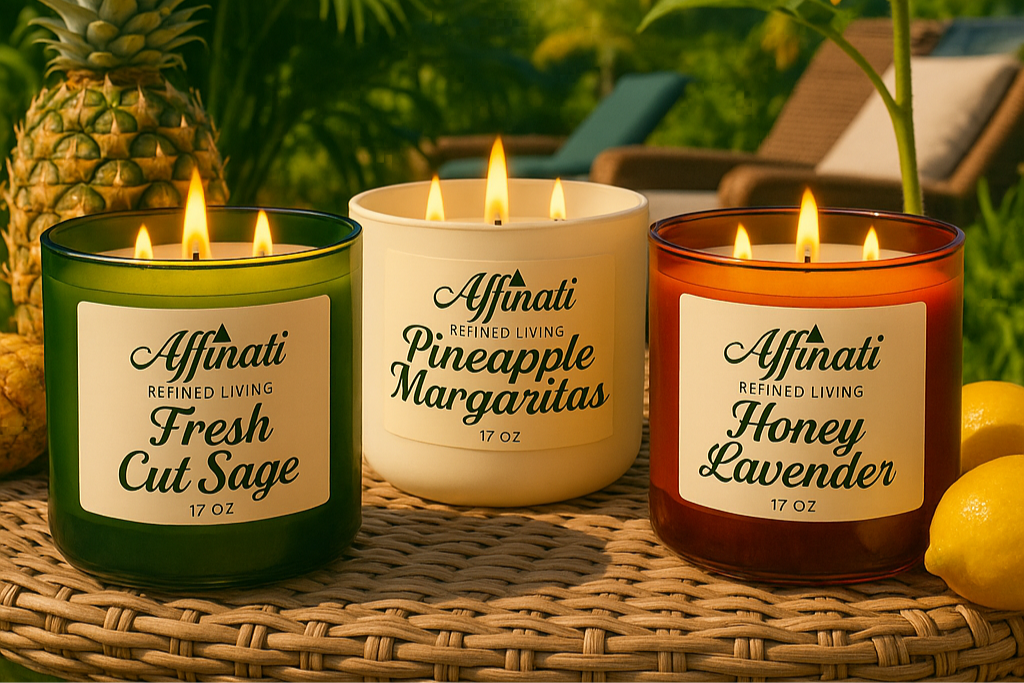
Are Bath & Body Works Candles Toxic? Safe Alternatives
Are Bath & Body Works Candles Toxic? What You Need to Know in 2025
Introduction
Bath & Body Works candles are everywhere — from holiday displays in malls to Instagram-worthy flat lays on coffee tables. Their iconic 3-wick candles and signature scents like Mahogany Teakwood, Leaves, and Eucalyptus Spearmint have made them one of the most popular candle brands in the world.
But in 2025, more consumers are asking: Are Bath & Body Works candles toxic? Are they safe to burn daily, or are they filling your home with hidden chemicals?
Let’s break down the ingredients, health concerns, and how they compare to cleaner candle alternatives like Affinati Soy Candles.
What Are Bath & Body Works Candles Made Of?
1. Wax:
-
Bath & Body Works uses paraffin wax blends.
-
Paraffin comes from petroleum — cheap and effective for fragrance throw but known for releasing soot and VOCs (volatile organic compounds).
-
Some candles also include small amounts of soy, but paraffin dominates.
2. Fragrance Oils:
-
Bath & Body Works candles use synthetic fragrance oils.
-
Some are phthalate-free, but formulas are proprietary.
-
Known for their strong throw — but often described as overpowering or chemical-like.
3. Wicks:
-
Cotton wicks, lead-free (as required by U.S. law since 2003).
-
Even with cotton, paraffin wax produces soot.
4. Dyes:
-
Bath & Body Works candles often use artificial dyes and colorants.
Why People Worry About Bath & Body Works Candles
When shoppers search “are Bath & Body Works candles toxic,” they’re usually concerned about:
-
Soot production – paraffin burns dirtier than soy.
-
Indoor air quality – VOCs like toluene and benzene can be released.
-
Synthetic fragrances – strong scents may trigger headaches, allergies, or asthma.
-
Residue – soot can leave black marks on walls, ceilings, and jars.
So while Bath & Body Works candles aren’t officially unsafe, they’re not the cleanest option for everyday use.
Customer Complaints About Bath & Body Works Candles
Looking at reviews, common issues include:
-
Headaches or migraines from strong scents.
-
Lingering chemical smell even after extinguishing.
-
Excess soot buildup around the jars.
-
Some customers reporting allergic reactions or breathing irritation.
This doesn’t mean every candle causes problems, but it’s clear they’re not ideal for people sensitive to artificial fragrances.
Are Bath & Body Works Candles Safe for Pets?
Pets have more sensitive respiratory systems than humans. The paraffin soot and synthetic fragrances in Bath & Body Works candles may irritate cats’ and dogs’ lungs.
While they aren’t directly poisonous, they’re not the safest choice for pet-friendly households. Clean-burning soy candles are a better option.
Bath & Body Works vs. Other Brands
Bath & Body Works vs. Yankee Candle
-
Both rely on paraffin wax.
-
Yankee scents can be lighter; BBW is known for stronger fragrance throw.
-
Both produce soot, but BBW’s strength makes it more likely to cause headaches.
Bath & Body Works vs. Goose Creek
-
Both paraffin-based, heavily scented, and soot-producing.
-
Goose Creek offers more unique gourmand scents; BBW dominates in mainstream seasonal favorites.
Bath & Body Works vs. Affinati Soy Candles
This is where the difference is clear:
| Feature | Bath & Body Works | Affinati Soy Candle |
|---|---|---|
| Wax | Paraffin blend | Soy (plant-based) |
| Burn | Soot-producing | Clean-burning |
| Longevity | Burns faster | Soy burns slower & longer |
| Fragrance Oils | Synthetic blends | Non-toxic, phthalate-free |
| Health Impact | VOCs & soot | Safer for home, family, pets |
The Verdict: Are Bath & Body Works Candles Toxic?
Short answer: Bath & Body Works candles are not immediately “toxic,” but they’re not the cleanest choice either.
-
Made with paraffin wax → produces soot and VOCs.
-
Uses synthetic fragrance oils → can trigger headaches and allergies.
-
Heavy, artificial scents may overwhelm sensitive users.
If you only burn them occasionally, you might not notice issues. But if you burn candles daily, switching to soy or coconut wax is a healthier choice for your home and family.
Why Affinati Soy Candles Are a Better Choice
At Affinati, we created candles with luxury fragrance and clean living in mind:
-
Soy wax — no petroleum by-products.
-
Non-toxic, phthalate-free fragrance oils.
-
3-wick jars for even burn and powerful, but natural, fragrance throw.
-
Long-lasting burn time — cleaner, safer, and more sustainable.
- Sophisticated scents like Mahogany Teakwood, Cherry Noir, Pumpkin Spice Latte, French Vanilla, Honey Lavender, and Kentucky Bourbon.
Affinati candles give you the same luxury ambiance as Bath & Body Works — without the soot, petroleum wax, or chemical-heavy fragrances.
FAQs
Are Bath & Body Works candles safe to breathe?
Not immediately dangerous, but paraffin wax and artificial oils affect air quality.
Do Bath & Body Works candles give headaches?
Many customers report headaches or nausea from their strong scents.
Are Bath & Body Works candles toxic to pets?
Not directly poisonous, but soot and heavy scents may irritate animals.
What’s the healthiest candle option?
Soy or coconut wax candles with non-toxic fragrance oils and cotton or wooden wicks.
What’s the best Bath & Body Works alternative?
Affinati Soy Candles — clean-burning, long-lasting, and non-toxic.
Final Thoughts
So, are Bath & Body Works candles toxic? They’re not immediately unsafe — but they aren’t clean-burning either. With paraffin wax, synthetic fragrances, and soot, they’re not the healthiest choice for everyday use.
If you love candles but care about air quality and safety, switching to Affinati Soy Candles is the clear upgrade. Designed with non-toxic ingredients, soy wax, and sophisticated scents, they deliver the same cozy atmosphere — without the hidden downsides.
Shop Affinati Signature Candles
Read More:
1. Buy Lotions with Free Shipping – Best Deals & Luxury Picks Online



